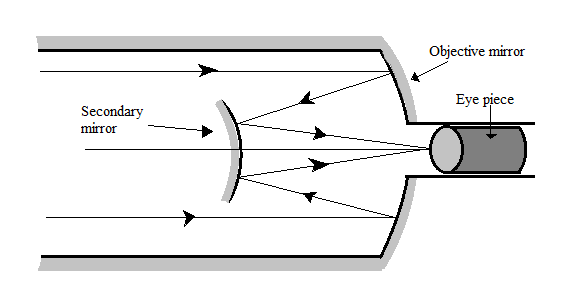
A Cassegrain telescope uses two mirrors as shown in the above figure. Such a telescope is built with the mirrors


Answer
480.6k+ views
Hint:In order to solve this question you have to know the concept of mirror formula for concave and convex mirror. Always remember that when there is given a Cassegrain telescope like in above diagram then the image formed by the objective will act as a virtual object for the secondary mirror.
Formula used:
Mirror formula is given as
Where
Complete step by step solution:
The distance between the objective mirror and the secondary mirror is given in the question,
The radius of the curvature of the objective mirror is also given in the question,
Hence, the focal length of the objective mirror is,
Also the radius of curvature of the secondary mirror is given in the question,
Hence, the focal length of the secondary mirror is,
The image formed by the objective mirror with an object placed at infinity, will act as a virtual object for the secondary mirror.
Hence, the image distance which acts as an object for the secondary mirror is,
On putting the values, we get
Now, Applying the mirror formula for the secondary mirror,
On putting all the values, we get
On solving this we get
Hence, the final image of an object at infinity will be formed
Note:The Cassegrain telescope is an reflecting astronomical telescope, in which light ray is incident on a concave mirror known as objective mirror and then the reflected ray incident on a smaller convex mirror known as secondary mirror and then finally this ray is also gets reflected through a hole in the concave mirror onto a eyepiece to finally form the image.
Formula used:
Mirror formula is given as
Where
Complete step by step solution:
The distance between the objective mirror and the secondary mirror is given in the question,
The radius of the curvature of the objective mirror is also given in the question,
Hence, the focal length of the objective mirror is,
Also the radius of curvature of the secondary mirror is given in the question,
Hence, the focal length of the secondary mirror is,
The image formed by the objective mirror with an object placed at infinity, will act as a virtual object for the secondary mirror.
Hence, the image distance which acts as an object for the secondary mirror is,
On putting the values, we get
Now, Applying the mirror formula for the secondary mirror,
On putting all the values, we get
On solving this we get
Hence, the final image of an object at infinity will be formed
Note:The Cassegrain telescope is an reflecting astronomical telescope, in which light ray is incident on a concave mirror known as objective mirror and then the reflected ray incident on a smaller convex mirror known as secondary mirror and then finally this ray is also gets reflected through a hole in the concave mirror onto a eyepiece to finally form the image.
Latest Vedantu courses for you
Grade 10 | MAHARASHTRABOARD | SCHOOL | English
Vedantu 10 Maharashtra Pro Lite (2025-26)
School Full course for MAHARASHTRABOARD students
₹31,500 per year
Recently Updated Pages
Master Class 12 Business Studies: Engaging Questions & Answers for Success

Master Class 12 English: Engaging Questions & Answers for Success

Master Class 12 Social Science: Engaging Questions & Answers for Success

Master Class 12 Chemistry: Engaging Questions & Answers for Success

Class 12 Question and Answer - Your Ultimate Solutions Guide

Master Class 12 Economics: Engaging Questions & Answers for Success

Trending doubts
Give 10 examples of unisexual and bisexual flowers

Draw a labelled sketch of the human eye class 12 physics CBSE

Differentiate between homogeneous and heterogeneous class 12 chemistry CBSE

Write a short note on Franklands reaction class 12 chemistry CBSE

Differentiate between insitu conservation and exsitu class 12 biology CBSE

What are the major means of transport Explain each class 12 social science CBSE




